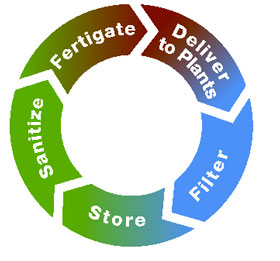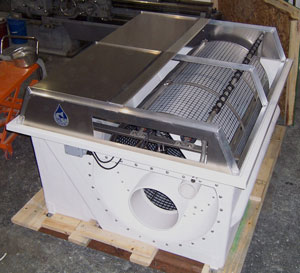1/25/2012
Goin' with the Flow
Thad Humphrey
Water is a critical element to the success of a greenhouse, and how it’s managed is directly related to the success of the crops within. While water can be captured and used in a variety of ways, it can be an expensive resource to treat. Recycling irrigation water provides the grower with a cost effective means to avoid overtreatment. However, use of recycled water requires additional filtration and sanitization to prevent the distribution of plant pathogens. As the cost to treat water significantly rises, growers are looking for maintenance-friendly alternatives to reduce treatment costs by using sustainable, efficient methods that minimize or eliminate consumables.
Before we discuss the details of sustainable treatment alternatives, let’s look at the big picture of how greenhouses use water. Water is typically captured from a source (such as ground water, municipal water, storm water, ponds, etc.). If the water isn’t fresh (such as pond water), it may require some form of basic pre-treatment to bring it from an anaerobic state to an aerobic state (to eliminate large, suspended organic solids such as algae, etc). Once the bulk of the large solids are removed, fine filtration is necessary to prepare the water for introduction into the recycled water system. The water is then stored and ready to distribute to plants through an engineered irrigation system (such as overhead spray, drip, sprinkler, hand watering, sub-irrigation, etc.). Refer to Figure 1 for a basic flow diagram of water capture and pretreatment.
 Figure 1: Ba
Figure 1: Ba sic flow diagram of irrigation water capture and pretreatment.
Figure 2: Basic flow diagram of sub-irrigation system water cycle.
sic flow diagram of irrigation water capture and pretreatment.
Figure 2: Basic flow diagram of sub-irrigation system water cycle.
Although there is a vast array of options to recycle water depending on the type of irrigation system, we’ll be focusing on advancements within greenhouse sub-irrigation systems. In a sub-irrigation system, stored water can be sanitized to remove pathogens that may harm plants. Fertigation can be introduced after sanitization. The fertigated irrigation water is delivered to the plants for consumption. Reclaimed (excess) irrigation water carries plant and soil particulate with it, which must be filtered out prior to recapturing for storage. Once the water is stored, the cycle can repeat with sanitization, fertigation, delivery and so on. Refer to Figure 2 for a basic flow diagram of sub-irrigation system water cycle.
Within the sub-irrigation system process, there are a number of process advancements that are currently available to the grower to help reduce or eliminate consumable costs, reduce operations and maintenance costs, and even reduce equipment space.
Advancement #1: Sanitizing your water with ozone
Effective methods to sanitize greenhouse irrigation water have traditionally been achieved using a variety of stored chemicals in combination with custom chemical delivery and monitoring systems. The appropriate chemical treatment is selected to meet the greenhouse water system needs, while taking into account the system’s initial investment cost—in addition to ongoing consumable, operations and maintenance costs. On-site storage of chemicals is typically required, which takes up space and is a liability to the property owner.
An alternative sanitizing method that greatly reduces the liability and cost behind stored chemicals and significantly reduces operations and maintenance costs is the use of ozone systems. These systems require very little electricity and require no stored chemicals since ozone is created and used on demand.
Local air is captured and transformed into an oxygen-rich supply of air. This is passed through a corona ozone generator that radially emits contained electric arcs that break apart some of the oxygen molecules (O2) in the oxygen-rich air, which are reformed as ozone (O3). Through the use of a venturi nozzle, small amounts of ozone gas (typically less than 1 ppm for an average greenhouse application) are directly injected into the water system. Of course, the amount of ozone required greatly varies depending on the sub-irrigation system water quality, so this must be factored in when sizing a system.
A vessel collects the ozonated water and allows the concentration to build up to a set level. During this process, oxidized products are dropped out of solution and are filtered out of the system. Because ozone is an unstable molecule, it quickly gives up its extra oxygen molecule and reverts back to its original state as oxygen (O2). If a batch treatment process is selected, there is no risk of ozone harming the plants, as there can be virtually no ozone residual once the batch treatment is complete. For in-line treatment processes, the ozone level must be dynamically monitored to ensure the correct residual is being maintained in the sub-irrigation system to avoid harming the plants. The result is a sanitized water supply, free of pathogens, that is ready for fertigation and distribution to the plants.
Advancement #2: Delivering water to your plants using a cascade floor system
A relatively new alternative to traditional ebb-and-flood floor irrigation is the cascade floor. Plants are placed on a precision-sloped concrete floor and irrigated by a constant thin stream of evenly distributed water, which travels from the high end of the floor to the low end of the floor (typically widthwise across the bay). Water uptake occurs by capillary action until the irrigation water is shut off. This gives cascade floors a unique advantage over flood floors because they can irrigate smaller plants while minimizing the risk of oversoaking. Fluid height can be adjusted by use of variable frequency drives (VFDs) on the fill pumps. A slower pump speed would reduce the water height on the floor, while a faster pump speed would increase the water height.
In contrast to ebb-and-flood floors, cascade floors typically have:
- Reduced water storage requirements and water management costs, as the recycled water is immediately captured and put back into the system for reuse.
- Significantly less valving and control points, as no drainage valves are required.
- Reduced construction costs.
- Slightly increased equipment operations and maintenance costs.
- Cascade floors can be a cost-effective and simpler alternative to ebb-and-flood irrigation with greater flexibility to irrigate a wider array of plant sizes.
 View of a fiberglass-enclosed drum filter.
Advancement #3: Filtering your water by gravity with minimal consumables
View of a fiberglass-enclosed drum filter.
Advancement #3: Filtering your water by gravity with minimal consumables
Roll media filtration has proven to be a reliable and effective way to filter greenhouse irrigation water to a sub-30 micron level and beyond. The main disadvantage to this system is the ongoing need to replace the filter media. An alternative to this design is a drum filter, which uses renewable filter panels that require replacement within a matter of years rather than months. Irrigation water enters the inside of a screened drum. The water flows by gravity through micro-screened panels to the outside of the drum where it can then be collected in storage tanks for reuse. The solids collect on the inside of the drum and eventually plug the panels. Once the panels are sufficiently blinded, the water level within the drum rises until it reaches the high level sensor set point. At this point, the level switch triggers the drum to rotate and turn on the high pressure backwash pump. The backwash pump delivers clean water through a high pressure spray bar located towards the upper outside of the screened drum, which sprays water through the screened panels, clearing the solids, which are then collected in a trough inside the drum. The solids are then drained to waste. As the screens clear, the water level within the drum drops until the normal operating water level is reached. At this point, drum rotation stops and the backwash pump shuts off. This cycle repeats at intervals that are dependent on the type and amount of solids being filtered and the pore size of the screens.
There are many available solutions to manage your greenhouse irrigation water. Consider these modern sub-irrigation system alternatives to traditional treatment methods and weigh their effectiveness to see if these systems are right for you. The result could very well be a sustainable, efficient, cost-effective and maintenance-friendly system that you’ll wish you had years ago.
GT
Thad Humphrey is a senior mechanical engineer with TrueLeaf Technologies. He can be reached at thumphrey@trueleaf.net or (800) 438-4328.
Managing Your Pond By Jennifer Duffield White
If you have a reservoir or surface pond for your greenhouse, this convenient source of irrigation water can also become a headache, especially when water temperature rises and algae blooms threaten to clog your irrigation system.
But before we talk about algae treatment, consider your pond conditions.
What algae love: light, moisture, warmth and nutrients. Thus, shallow ponds that receive lots of light and the corresponding warm water temperatures are a prime breeding ground for algae. Algae also thrive in stagnant water. And if you want to spread algae problems into your greenhouse, too, look to over-irrigation, poor sanitation, poor drainage and high nutrient levels. Don’t forget, these green nuisances travel not only in water, but also via pots and growing media.
Long-term prevention
You can start to gain control of your pond by managing the physical aspects of the pond, first.
- Keep your nutrient levels in check, especially phosphorus and nitrogen, which are a tasty, nutritious meal for your algae. This will be particularly important if you’re putting recycled irrigation water with nutrients into your pond.
- If you have nutrients that may be running off agriculture fields or outdoor production areas into your pond, you can look at planting vegetative filtration strips, which slow down runoff and allow it to soak into the ground, instead. Iowa State has recommendations at www.extension.iastate.edu/Publications/PM1507.pdf.
- Don’t allow your pond to stand stagnant. Small waves/surface water movement can inhibit algae growth, and a pond aeration system can be a grower’s best friend in this situation. (For example, DRAMMwater now offers growers custom-designed aeration systems.)
- Make it deeper. If you have shallow areas of your pond (less than 3 ft. deep), you might consider dredging your pond to make it deeper. Also, look at the angle of your banks; shallow water here can also cause a problem.
Short-term treatment
No matter what you do to the physical nature of your pond, you’ll probably still have to deal with algae on some level, in which case you have a few treatment options to consider. All of these methods are best when started early, before you have a massive algae bloom.
- Chemical algaecides are the traditional way to treat algae growth. These include copper compounds, hydrogen peroxide compounds and oxidants (marketed under various trade names). You can also apply a dye (Aquashade) that blocks some of the necessary light.
- Some pond owners have found success with applying barley straw to their ponds. Purdue University has a publication on the topic at www.btny.purdue.edu/Pubs/APM/APM-1-w.pdf.
- Physical removal. Yes, you can get in there and pull it out. But in a Purdue Extension bulletin, authors Diane M. Camberato and Roberto G. Lopez warn that this works best for small ponds, as larger ponds require expensive harvesting equipment.
- Biological control. Fish, of course, are great weed eaters and can help control vegetative problems in your pond. Grass carp are a favored fish. However, don’t forget that fish won’t cohabitate well with some of the chemical treatments, especially copper sulfate.
Further reading: “Weed Control in Irrigation Supplies,” a publication by North Carolina State University Extension, offers further details on these preventative and control techniques. Available at
www.weedscience.ncsu.edu/aquaticweeds/ag-438.pdf.
GT